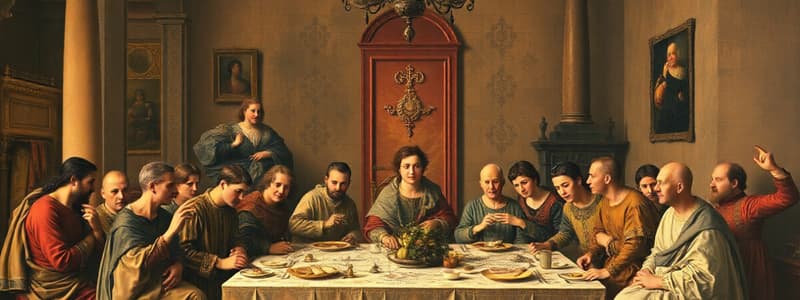Podcast
Questions and Answers
How did Veronese primarily respond to the Inquisition's criticism of his inclusion of 'irreverent details' in 'Feast in the House of Levi'?
How did Veronese primarily respond to the Inquisition's criticism of his inclusion of 'irreverent details' in 'Feast in the House of Levi'?
- He publicly apologized and vowed to adhere strictly to religious guidelines in future works.
- He altered the painting to remove the objectionable figures and elements.
- He changed the title of the painting to reflect a less solemn biblical scene. (correct)
- He repainted the entire artwork to align with religious doctrine.
Which artistic movement is most closely associated with Paolo Veronese's style, characterized by its theatricality and use of foreshortening?
Which artistic movement is most closely associated with Paolo Veronese's style, characterized by its theatricality and use of foreshortening?
- Early Renaissance
- High Renaissance
- Mannerism (correct)
- Baroque
What distinguishes Veronese's use of color in his paintings from that of other artists during the Venetian Renaissance?
What distinguishes Veronese's use of color in his paintings from that of other artists during the Venetian Renaissance?
- He primarily used monochromatic palettes to emphasize form over color.
- He is known for his vibrant color palette, contributing to the grandeur and opulence of his works. (correct)
- He favored muted, earthy tones to convey a sense of humility.
- He avoided the use of blue pigments due to their high cost and instability.
In 'Feast in the House of Levi', how does Veronese use light to draw attention to Christ?
In 'Feast in the House of Levi', how does Veronese use light to draw attention to Christ?
Besides linear perspective to create depth, what architectural element does Veronese incorporate in 'Feast in the House of Levi' to frame the scene?
Besides linear perspective to create depth, what architectural element does Veronese incorporate in 'Feast in the House of Levi' to frame the scene?
What classical influence is evident in Veronese's works, reflecting the humanist ideals prevalent during the Renaissance?
What classical influence is evident in Veronese's works, reflecting the humanist ideals prevalent during the Renaissance?
How does Veronese's 'Feast in the House of Levi' exemplify the artistic tensions of the late Renaissance?
How does Veronese's 'Feast in the House of Levi' exemplify the artistic tensions of the late Renaissance?
Which of the following is a key characteristic that defines Paolo Veronese's artistic style?
Which of the following is a key characteristic that defines Paolo Veronese's artistic style?
What might be inferred from Veronese's decision to change the title of 'Feast in the House of Levi' rather than alter the painting itself?
What might be inferred from Veronese's decision to change the title of 'Feast in the House of Levi' rather than alter the painting itself?
How did Veronese break from or continue the traditions established by earlier Venetian painters within his 'Feast in the House of Levi'?
How did Veronese break from or continue the traditions established by earlier Venetian painters within his 'Feast in the House of Levi'?
Flashcards
Paolo Veronese
Paolo Veronese
A Venetian Renaissance painter known for monumental works, vibrant colors, and masterful use of light.
Feast in the House of Levi
Feast in the House of Levi
A painting by Veronese, originally intended as a Last Supper scene, but renamed due to controversy.
Linear Perspective
Linear Perspective
A painting technique that creates the illusion of depth on a flat surface using converging lines and a vanishing point.
Greco-Roman Elements
Greco-Roman Elements
Signup and view all the flashcards
Mannerist Style
Mannerist Style
Signup and view all the flashcards
Study Notes
- Paolo Veronese (1528–1588), born Paolo Caliari in Verona, was a prominent painter of the Venetian Renaissance, following Titian, Tintoretto, and Giorgione.
- Veronese painted in the Mannerist style.
- Veronese's strong Catholic faith led him to depict Christian parables in the Venetian style of the mid- to late-sixteenth century.
- Veronese was known for monumental works, vibrant colors, and masterful use of light.
- His art epitomized the grandeur and opulence of 16th-century Venetian painting.
- Veronese's style featured balanced composition, dynamic figures, and intricate architectural settings.
- Inspired by classical antiquity, his work incorporated Greco-Roman elements.
- Veronese's talent for depicting grand narratives was matched by his technical precision and theatrical sense, typical of the Mannerist style with foreshortening on ceilings.
Feast in the House of Levi
- "Feast in the House of Levi" was originally intended as a Last Supper.
- This enormous painting is 18 x 43 feet (555 cm x 1309 cm).
- It was commissioned to replace a Last Supper fresco by Titian that had been destroyed by fire.
- Veronese faced criticism from the Catholic Church for including details like dwarfs, soldiers, drunken Germans, and a dog in the scene.
- The Inquisition ordered him to "correct" the painting, but instead, he changed its title, reframing it as a different biblical feast.
- This highlights tensions between artistic expression and religious orthodoxy in the late Renaissance.
- Veronese uses linear perspective to create depth, with pillars and archways framing the scene.
- A marble cityscape in the background adds to the sense of space.
- Light is strategically used to highlight Christ, with the sky near him appearing nearly white.
Studying That Suits You
Use AI to generate personalized quizzes and flashcards to suit your learning preferences.




